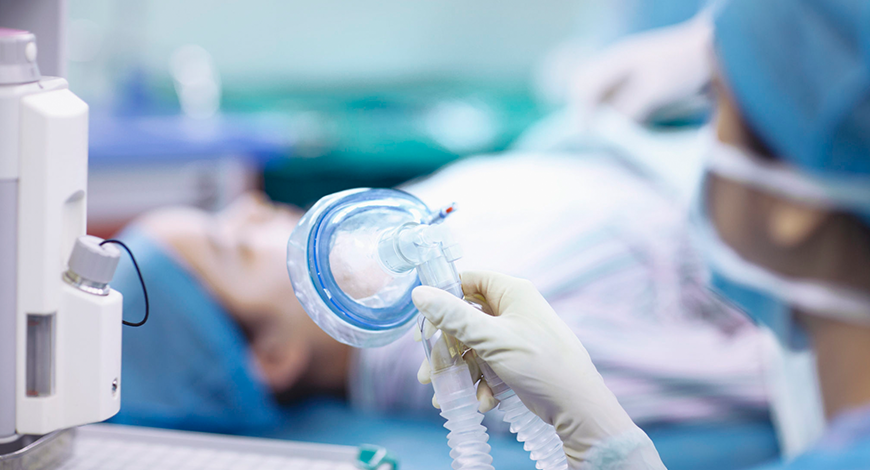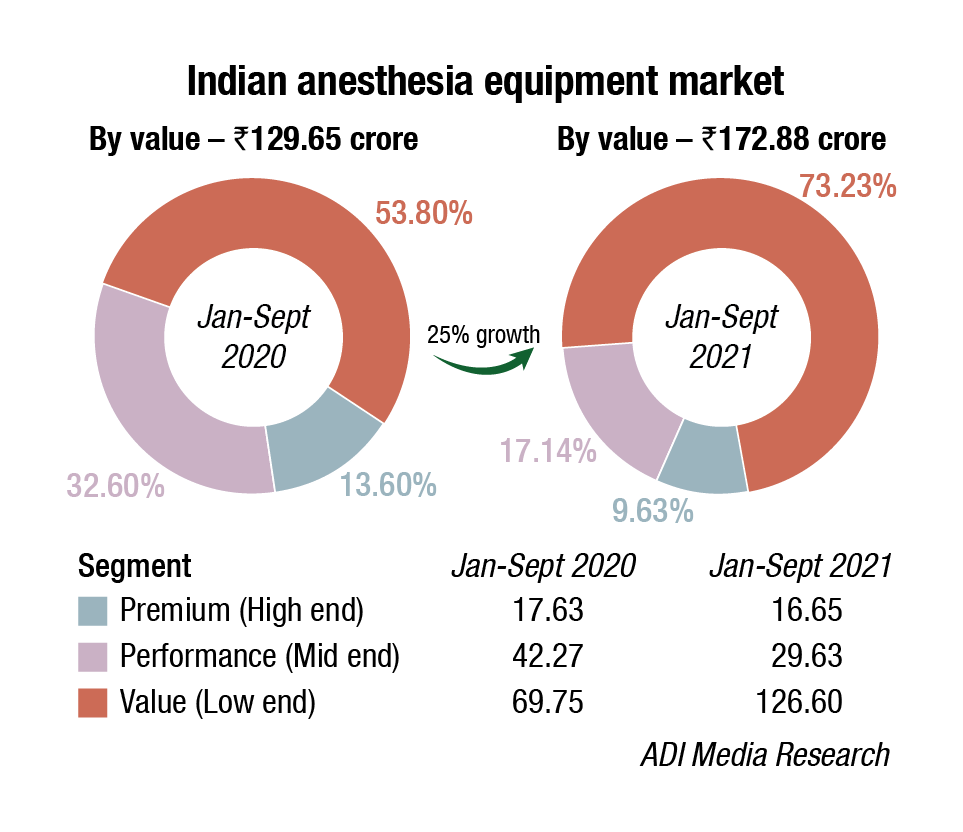Anesthesia Equipment
Anesthesiology, automation, and analytics

Despite tremendous advancements in clinical monitoring technology and clinical practice development over the previous several decades, there is still much more to be done.
Technological advancement appears to have influenced all aspects of life in the universe, leading to remarkable changes in the society. Currently, the world is flooded with new technologies and scientific discoveries and more are still emerging. This implies that these new technologies and scientific inventions will exert an immense impact on society. However, the wave of technological advancements seems to favor some fields with others experiencing the shock of technology impact. Interestingly, the field of healthcare and medicine are some of the beneficiaries of the newly emerging technologies; hence, medical practice has become relatively sophisticated owing to advanced delivery of care, treatment of chronic diseases, and identification of newly emerging diseases and health conditions. It is worth noting that healthcare systems and the scope of medical sciences of the 21st century are relatively different from the 19th-century versions because the impact of technological developments in the last decade seems to have transformed healthcare delivery systems with some of the newly invented technologies, producing extraordinary performances. However, it is worth noting that technological advancement in healthcare and medicine has not only led to the discovery of new drugs but it has also improved safety and precision in clinical investigations. Moreover, it has led to the emergence of new medical procedures, which have, in turn, improved the quality of care offered to patients by healthcare professionals. For instance, the practice of anesthesia, which is seemingly built on technological advances, appears to have achieved a remarkable progress, especially with regard to the quality of care, owing to a number of technologies developed in the past decade.
The modern anesthesia machine has gradually evolved from simply a means to anesthetize and oxygenate a patient to an anesthesia workstation, incorporating increasingly complex ventilator modes, end-tidal CO2 monitors, end-tidal anesthetic concentrations, minimal alveolar-concentration estimators, and a means of monitoring vital signs. Despite all these innovations and new instruments added to the anesthesia machine, an understanding of the anesthesia machine is still a core component of the practice of anesthesiology.
The Indian anesthesia equipment market in 9M 2021 (January–September) is estimated at ₹172.87 crore, in comparison to ₹129.7 crore in 9M 2020. The market in 2021 seems to have moved in favor of the value segment, which while having seen an increased demand, also gained share from both the premium and performance models. This is in strong contrast to 2019, when the performance segment dominated with a 50-percent share. The prices have remained relatively stable.
 In the 9M period in 2021, the government finalized orders against bids invited, but did not invite any fresh tenders. Orders were placed by the states; the Center, in line with the Make in India initiative, stayed away. For instance, AIIMS, New Delhi, did not finalize its orders, as indicated earlier. India saw many machines donated as part of the companies’ CSR activity, including from overseas companies, like Amazon.
In the 9M period in 2021, the government finalized orders against bids invited, but did not invite any fresh tenders. Orders were placed by the states; the Center, in line with the Make in India initiative, stayed away. For instance, AIIMS, New Delhi, did not finalize its orders, as indicated earlier. India saw many machines donated as part of the companies’ CSR activity, including from overseas companies, like Amazon.
| Indian anesthesia equipment market | |||
| Major vendors* – 2021 | |||
| Tier I | Tier II | Tier III | Others |
| GE | Mindray | BPL-Penlon and Drager | Allied Medical (Meditec England), Skanray, Aeon Medical, local & regional brands |
| *Vendors are placed in different tiers on the basis of their sales contribution to the overall revenues of the Indian anesthesia equipment market. | |||
| ADI Media Research | |||
In the 9M period in 2021, the government finalized orders against bids invited, but did not invite any fresh tenders. Orders were placed by the states; the Center, in line with the Make in India initiative, stayed away. For instance, AIIMS, New Delhi, did not finalize its orders, as indicated earlier. India saw many machines donated as part of the companies’ CSR activity, including from overseas companies, like Amazon.
The market since October 2021 is returning to normalcy. Corporate chains are inviting RFPs, and the smaller hospitals are also exploring the market. However, the government has so far given no indication that it has any major expansion or procurement plans.
The Indian buyers are warming up to the high-flow nasal cannula (HFNC) oxygen machines being introduced by various brands. These high-end machines extend safe apneic time from 8 to up to 30 minutes to help clinicians intubate more easily, integrate automatic controlled anesthesia that automatically adjusts fresh gas and vaporizer output to quickly achieve pre-set target end-tidal agent and inspiratory oxygen concentration, and while reducing cost by minimizing the consumption of gas and agents used throughout the case, also cuts down on workload for clinicians.
The global anesthesia machines market is expected to grow from USD 9.44 billion in 2020 to USD 12.77 billion in 2021 at a compound annual growth rate (CAGR) of 35.3 percent. The growth is mainly due to use of anesthesia machines being converted to ventilators to support the patients affected by Covid-19, which has spiked the demand for the equipment. The anesthesia machines market is expected to reach USD 18.62 billion in 2025 at a CAGR of 9.9 percent.
Based on the products, the anesthesia machines segment accounted for the largest segment accounting for more than 50 percent share of the total market in 2021, due to the increasing number of surgical procedures and rising awareness about preventive healthcare measures. However, the anesthesia disposables segment is expected to witness double-digit growth rate throughout the coming years. Among the anesthesia machines segment, anesthesia-delivery machines sub-segment held the largest revenue share, while anesthesia ventilators sub-segment is anticipated to register fastest growth rate during 2021–2025.
The introduction of new monitoring techniques, such as monitoring the depth of anesthesia, goal-directed fluid therapy, advanced neurological monitoring, improved alarm system, and technological advancements in objective pain assessment, is driving innovation in the industry. The newer machines use advanced electronics, software, and technology to offer extensive capabilities for ventilation, monitoring, inhaled-agent delivery, low-flow anesthesia, and closed-loop anesthesia. The modern integrated anesthesia workstation is designed to be a complete anesthesia and respiratory gas-delivery and monitoring system. Advanced anesthesia care station offers integrated monitoring and recording facilities and seamless integration with anesthesia information systems. It is possible to deliver tidal volumes accurately and eliminate several hazards associated with the low-pressure system and oxygen flush. Modern anesthetic machine incorporates several safety devices, including an oxygen-failure alarm, nitrous cut-off or oxygen failure protection device, hypoxic-mixture alarms, ventilator alarms, etc.
ANESTHESIA MACHINE WITH ELECTRONIC GAS MIXER-AN INTELLIGENT AND RELIABLE PARTNER
 MANJU GOYAL
MANJU GOYAL
National Product Manager –
Life Support,
Mindray Medical India Pvt. Ltd.
During many years in anesthesia, we have seen transition from Boyles apparatus to external ventilator machines, from external ventilator machines to integrated ventilators – two-gas version. Now, we have come far with three-gas machines, having various ventilation modes. We often have experienced the conversation between cascaded flow meters and electronic flow meters as to which one is more user-friendly, accurate, safe, etc. But as both of these technologies have mechanical way of mixing, so the only way you see the fresh gas flow (as flow tubes or digital) changes, but for the machine, internally its mechanical mixing only. So both have the same kind of limitations, like setting independent flow for each gas, and the user spends a lot of attention in titration of adequate flows to meet minimal flow anesthesia and maintain the balance of anesthesia. As the case progresses, he need to manually adjust O2 as per the change in the patient uptake.
All this extra work can be managed if you have an intelligent and careful technical partner. That can be your anesthesia machine with electronic gas mixer. This will take titration job of gases on itself and will take away some concerns including leaks. Many anesthetists have a concern as to what flows are adequate for delivering the set tidal volume at the lowest fresh gas flow. In this regard, they again do a titration work to set adequate flow, and in case leak starts, that flow need to be changed again. This extra load you can leave on your intelligent anesthesia machine to do. The mixer will inform you that your gases are not enough for tidal-volume delivery, or if these are more than what is actually needed. This will be more reliable as the feedback comes from the heart of the machine and not from external signs.
Electronical gas mixing is a well-established technology in ICU ventilators, and has been found reliable over the years in anesthesia machines as well. This demand is set to increase as anesthetists can benefit from this technology, and cost of operation can also be reduced.
The use of computer-controlled anesthesia machines is an emerging trend in the anesthesia machines market. Computer-controlled anesthesia machines help in reducing the patient’s pain during surgical procedures, and also provide features, such as alarms, to notify in case of an emergency or backup required to switch the defected pipeline or cylinder. For example, the Dräger Primus anesthesia workstation provides advanced display and monitoring settings and automatic checkup option, thereby reducing human time and efforts. Similarly, GE Healthcare’s Aisys CS station manages the oxygen flow, records the consummation data, and avoids wastage of fresh gas.
Thus, increasing investments, which are supporting the technological advancements in anesthesia monitors, are having a major impact on the market’s growth, enabling faster deployment in the healthcare industry.
Stringent government regulations and high installation costs are some of the factors that are expected to stymie market expansion to some extent. A key limitation for the anesthesia devices market is the risk of contamination, caused by the use of anesthetic machines during surgical procedures. This is mostly due to increase in the number of surgeries and use of anesthetic machines, which increases the risk of bacterial infections. Microorganisms frequently infect anesthesia devices. One example is the exterior section of an anesthetic machine, which includes bacteria that can be transported from the equipment to the anesthetist and then to the patient, causing bacterial contamination and illness. Creation of anesthetic systems is a time-consuming and complicated process, and lack of standards for their validation and repeatability is hindering anesthesia machinery market growth.
North America is expected to dominate the overall market over the next four years. In the North American region, the United States holds the largest market share, and this is due to the rapid increase in a number of diseases, such as obesity, cardiovascular problems, and different types of cancers, which have contributed to the rise in the number of surgeries of both open as well as minimally invasive types.
The anesthesia devices market is moderately competitive and consists of several major players. In terms of market share, few of the major players currently dominate the market. With the rising patient awareness levels and high prevalence of diseases and a rising number of surgeries, a few other smaller players are expected to enter into the market in the coming years. Some of the major players of the market are GE Healthcare, Becton Dickinson and Company, Smiths Group plc, Ambu S/A, Teleflex Incorporated, Ventlab, Drägerwerk AG & Co. KGaA, SunMed, 3M Company, and Airsep Corporation. The other players operating in the industry include Koninklijke Philips NV, Aircraft Medical, Verathon Inc., Karl Storz GmbH & Co. KG, and Pentax.
Improvements in perioperative technology allow the automatic and reliable collection, storage, and presentation of patient data during the perioperative period. The combination of immediate feedback and extensive details on a patient’s medical history allows the anesthesia community to focus on the patient in a timely manner. Anesthesia technology advancements are improving patient care. Developments that have become available in recent years include progress in software, such as in anesthesia information management and clinical decision support systems (AIMS and CDSS systems).
 DR SUSHMA SAROA
DR SUSHMA SAROA
Consultant Anesthesiologist,
Sir Ganga Ram Hospital
“Over the years, the conventional anesthesia machine has evolved into an advanced carestation. The new machines use advanced electronics, software, and technology to offer extensive capabilities for ventilation, monitoring, inhaled-agent delivery, low-flow anesthesia. and closed-loop anesthesia. They offer integrated monitoring and recording facilities and seamless integration with anesthesia-information systems. It is possible to deliver tidal volumes accurately and eliminate several hazards associated with the low-pressure system and oxygen flush. Appropriate use can result in enhanced safety and ergonomy of anesthetic delivery and monitoring. However, these workstations have brought in a new set of limitations and potential drawbacks. There are differences in technology and operational principles amongst new workstations. Understanding the principles of operation of these workstations and having a thorough knowledge of the operating manual of the individual machines is mandatory.”
The increasing use of AIMS and CDSS systems across anesthesia departments and practices has enabled the establishment and growth of large data sets, describing anesthesia patients, procedures, and outcomes. These data sets present a potential, prediction, decision, support, and ultimately allow data transmission to quickly integrate information directly from the monitors in real-time and provide vital information to the anesthesia specialist.
 DR SANTUSHTI VIJAY
DR SANTUSHTI VIJAY
Consultant Anaesthesia,
EHCC Hospital, Jaipur
“Anesthesia machine is used to deliver anesthetic agents to patients, and to evaluate their response toward anesthesia during surgical process. We are witnessing increasing trend of surgical procedures in hospitals, and thus increasing the need for anesthetic devices.
Like advancements in all other medical specializations, continuous and sustained research and development is evident in anesthesia also. The latest monitoring techniques, including advanced neurological monitoring, goal-directed fluid therapy, monitoring the depth of anesthesia, improved alarm system, and objective pain assessment are only tip of the iceberg of innovation in the industry. In the current scenario, Covid-19 has had a major impact on businesses across industries. But as soon as the graph of Covid-19 patients started going down, the demand for anesthesia machines started going up, which is reflecting favorably on global sales of anesthesia machines.
Increasing investments for technological advancements in anesthesia monitors are having a major impact on the market’s growth, enabling faster deployment in the healthcare industry.”
Advancements in hardware in ultrasound machines for applications, such as echocardiography, regional anesthesia, or central-line placement are improving patient care as well. The current monitoring system using electroencephalographic depth of anesthesia monitoring focuses on a reliable separation of different hypnotic levels that range from fully awake to (burst) suppression.
Prevention of too deep anesthesia may help to reduce delirious outcomes. Lately, new approaches to clinical airway management, such as airway algorithms, video laryngoscopy, and advanced supraglottic airway devices are also protecting patients from injury. Video laryngoscopy offers the advantage of improved glottic visualization and a higher first-attempt endotracheal intubation success rate in both predicted and unexpectedly difficult airways. Its use also is associated with a high success rate of rescue intubation while many supraglottic airway devices with specific designs for better ventilatory performance and higher patient safety have also been developed.
In the same manner, recent advances in noninvasive monitoring devices that track the patients’ vital signs are helping improve patient treatment. Fsmart pumps, computer-controlled drug-infusion delivery, and noninvasive monitoring systems are just a few examples. A recent article by JA Galvez, MD, assistant professor of anesthesiology and critical care at the University of Pennsylvania and The Children’s Hospital of Philadelphia, cites several noninvasive monitoring devices. For instance, a cloth sensor that is applied to a patient’s neck and employs acoustic signal-processing to monitor the patient’s respiratory rate. It uses an acoustic sensor method that has been shown to be more precise than thoracic impedance and better tolerated than capnometry with a face mask in obese patients recovering from anesthesia.
Technological advancements and emerging trends in anesthesia
 Subhodra Sahu
Subhodra Sahu
Senior Application Specialist, R&D,
Skanray Technologies Ltd.
Anesthesia workstation has evolved over many years from a simple inhaler of volatile anesthetic mixture to an anesthetic workstation with precision calibrated delivery of inspired agents, along with integrated ventilator, breathing system, patient monitoring system, and an integral suction unit for all-round monitoring and effective anesthetic procedure. High-flow oxygen therapy (HFOT) is becoming a standard of care in OT. It is administered before induction to improve the oxygen reserve of the patient, where intubation may get prolonged due to difficult airways. It also supports quick reversal after the procedure is over.
The scientific advancements of various modules in anesthesia workstations enhance safe induction, maintenance, and recovery of patients during surgical procedures.
Depth of anesthesia using EEG
Anesthetic depth is the degree to which the central nervous system is depressed by an anesthetic agent, based on the potency of the anesthetic agent and the concentration in which it is administered. Depth of anesthesia monitors might help to administer accurate drugs against the measured state of arousal of the patient. In addition, the avoidance of excessive anesthesia improves patient outcomes. Monitoring the depth of anesthesia throughout the procedure is being practised as standard procedure in today’s scenario.
Trend of using neuromuscular monitoring
Neuromuscular monitoring (NMT) is good guidance whenever there is a need to use the neuromuscular blockade to significantly improve the quality of intubation, and reduce airway injury. Neuromuscular monitoring is now being adopted widely as neuromuscular-blocking drugs have become a part of the general anesthesia, which otherwise would avoid postoperative residual curarization in the patient.
Closed-loop anesthesia delivery is becoming the preferred practice
With the advent of the depth of anesthesia, the closed-loop anaesthesia delivery is being preferred. This module automatically adjusts the delivery of anesthetic agents to maintain optimal sedation levels of the patient during surgery.
Modern anesthetic workstations are equipped with smart audio and visual alarms that significantly improve patient safety, and reduce the stress level of the clinical team in the OT. All vital data are continuously streamed to hospital information system (HIS), which is critical to keep the patient’s records updated in real time.
Another attractive class of devices is Zacceleromyographic (AMG) monitors. These devices measure the acceleration, using a piezoelectric sensor attached to a freely moving thumb. These devices take advantage of the direct proportionality between acceleration and force to measure the evoked force of the thumb. A significant impediment to this type of monitoring is the fact that the piezoelectric sensor may not always be properly aligned to the optimal plane of the thumb movement. Several other attractive noninvasive monitoring systems, smart pumps, and computer-controlled drug infusion delivery, have been released and promoted in the anesthetics community and to the general public as accessible vital signs-tracking systems. Integrated pulse oximeters, smartphone electrocardiogram, single-lead devices, and applications for at-home screening for intermittent hypoxia in children are also now available.
Despite these advances, the machine is still prone to user error, and thus requires the attention and focus of all operating room personnel in anticipation of a dreaded scenario of failure to oxygenation/ventilate or anesthesia awareness. Although an understanding of the intricate working of the anesthesia machine is not a requirement of all operating room staff, familiarity and awareness of components of the machine may help provide a safer anesthetic to the patient.
Healthcare team awareness of the location of a bag-valve-mask or self-inflating bag to hand off to the anesthesia provider can provide a temporary means of oxygenation and ventilation until anesthesia machine issues are resolved, if the machine fails. Familiarity with the flaws of a low-pressure, circle-circuit anesthesia machine that is complex and prone to leaks may allow for greater confidence in nursing and allied health professionals to point out when a tube is disconnected so the anesthesia provider can quickly resolve issues to prevent unnecessary adverse outcomes. With the emphasis on faster turn-over times between cases, it can be easy for operating room staff to forget that the anesthesia machine is the most important piece of equipment in the operating room. Failure of its proper function can lead to hypoxia and death or anoxic brain injury in a matter of minutes. Although routine, anesthesia providers must have the time they need to check the machine and ensure its proper functioning before the arrival of a patient to the operating room, so concerns and issues can be addressed safely and effectively.
The future trends of innovation in anesthesia follow two major directions – automation and analytics. When compared to manual distribution, the equipment and delivery of drugs can be completely automated to obtain a variety of benefits. Monitoring in the ICU and anesthesia generates a lot of data, but most of it is wasted. Innovative analytic methods may make it possible to use this data to develop new insights that can help with healthcare. Personalized use of data for returning patients and precision medicine is one of the options for using analytics in anesthesia and ICU.












